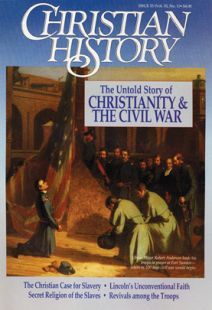Christianity and the Civil War: A Gallery of Other Key Figures
Harriet Tubman
(1820?—1913)
The “Moses” who set people free
In 1849 Tubman, a Baltimore slave, escaped to Philadelphia and freedom. She returned in 1850 to guide her sister and two nieces to freedom, and then other relatives (including her aged parents), and eventually between sixty and three hundred slaves. At one time, Southern reward for her capture stood at an astounding $40,000.
During the Civil War—which she had foreseen in a vision years earlier—she served both as a nurse and a northern spy and scout, securing military information from blacks behind Confederate lines.
Tubman, sometimes called “the Moses of her people,” was a deeply religious woman who never doubted that her actions were guided by God through omens and dreams.
William B. Johnson
(1782–1862)
Architect of the Southern Baptist Convention
Converted at age 12, Johnson soon became convinced of a call to ministry. Pastor of various churches, he also served as headmaster of a number of schools.
His interest in missions led him to suggest the inaugural meeting of the General Baptist Missionary Convention and to become its president from 1841 to 1844. A number of Baptists in the South then decided to separate from the Convention, because they were increasingly troubled over the abolitionist leanings and decisions of their northern brethren. Johnson was the leading architect of a new denomination, the Southern Baptist Convention.
The split, as well as the sundering of the Presbyterian and Methodist churches, dealt a psychological blow to North and South. If the churches couldn’t find a peaceful way out of the slavery issue, what hope was there for the country?
Sojourner Truth
(c. 1797–1883)
Her name defined her mission
Isabella Baumfree was born a slave to a Dutch master in New York who, after her escape in 1827, granted her freedom. She became a domestic helper in New York City.
At age 46 or 47, she had a vision of God telling her to “travel up an’ down the land showin’ the people their sins an’ bein’ a sign unto them.” This she did, with a new name that defined her mission. She never learned to read or write, but speaking in a heavy Dutch accent, she spread the abolitionist message, using biblical allusions.
During the war she met President Lincoln. After 1865, she worked for the benefit of freed slaves.
George Hay Stuart
(1816–1890)
He financed “ambassadors for Jesus” to the Civil War soldiers
Stuart emigrated from Ireland at age 15. With no formal education, he became a successful Philadelphia banker and dry-goods wholesaler.
In 1861, during an informal convention of the YMCA (Stuart was chairman of the central committee), the United States Christian Commission was born, with Stuart becoming its permanent chairman. It aimed to promote “the spiritual good of the soldiers in the army, and incidentally their intellectual improvement and social and physical comfort.”
The commission used lay people as “ambassadors for Jesus” who followed troops. They preached, held prayer meetings, and distributed Bibles, tracts, hymn books, hospital supplies, and food. Stuart collected $6 million and enlisted 5,000 volunteers; distributed were 1.5 million Bibles, 9 million books, and 30 million tracts.
John William Jones
(1836–1909)
Southern army chaplain
“Any history of this army which omits an account of the wonderful influence of religion upon it—which fails to tell how the courage, discipline, and morale was influenced by the humble piety and evangelical zeal of many of its officers and men—would be incomplete and unsatisfactory.”
So wrote chaplain J. William Jones of Robert E. Lee’s Army of Northern Virginia. Indeed, revivals among Confederate soldiers accounted for about 100,000 conversions.
Jones was ordained in the Southern Baptist Convention in 1860 and was headed for China as a missionary when the war broke out. He enlisted as a private in the Confederate army, but within a year he began serving as a chaplain. Jones, along with other chaplains, ministers, and officers, played a prominent role in a series of revivals that swept Lee’s Army in 1862–63. He later recorded these events in his Christ in the Camp (1877).
By the Editors
[Christian History originally published this article in Christian History Issue #33 in 1992]
Next articles
American Slavery: How Bad Was It?
Selections from the most powerful anti-slavery pamphlet ever written.
Theodore WeldBroken Churches, Broken Nation
When slavery divided America’s churches, what could hold the nation together?
the EditorsRevivals in the Camp
At first, most Civil War soldiers cared little for religion. But as the bloody war dragged on, hundreds of thousands converted to Christ.
Gardiner H. Shattuck, Jr.Support us
Christian History Institute (CHI) is a non-profit Pennsylvania corporation founded in 1982. Your donations support the continuation of this ministry
Donate



